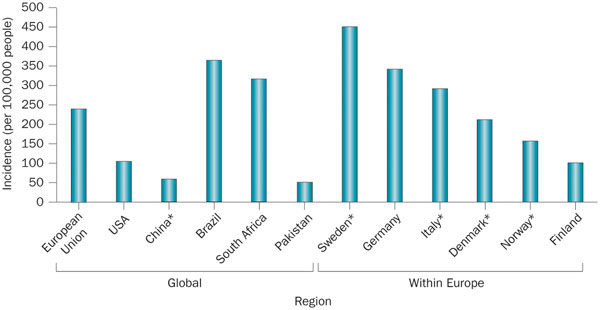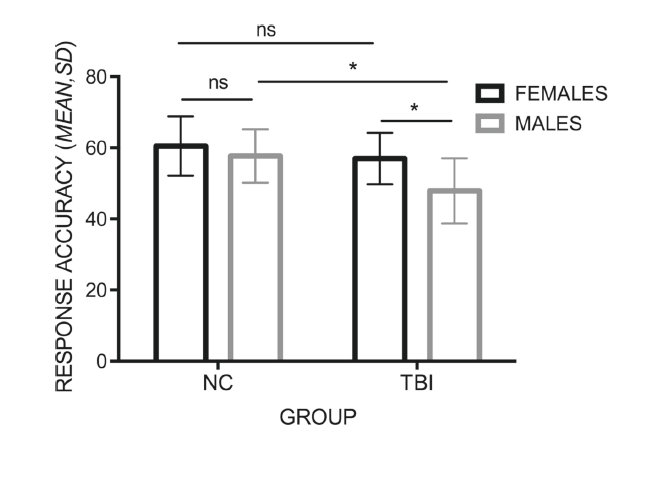Traumatic brain injury (TBI) is a major public-health problem around the world. In the United States, around 1 in a 1,000 people suffer TBI—around 1.7 million people every year—although the number can be much higher in other countries, as shown in the figure below.

The impact of TBI on survivors and loved ones can be devastating. One moment life is normal, and the next moment it has abruptly changed. Our brain defines who we are, and the consequences of a brain injury can affect all aspects of a patient’s life.
One type of fallout often observed with TBI is a social impairment arising from an inability to recognize facial affect. Nearly 40% of people with moderate to severe TBI are known to be impaired at recognizing facial affect—that is, they cannot tell whether a person is happy or sad from looking at their face. This affect-recognition impairment predicts poor social integration and socially inappropriate behaviors. If you don’t know whether someone is sad, then it is easy to tease someone or tell a silly joke in a very inappropriate context.
To date, the extent of social impairment that can be expected after TBI has been difficult to predict: Neither severity per se nor site of the trauma are sufficient to make accurate predictions about the extent of social impairment, although both play a partial role.
Another candidate predictor turns out to be the patient’s sex. There is much research that attests to a female advantage in emotion recognition from an early age on. Women are just better at reading faces than men. It is conceivable, therefore, that being female may offer some protection against the impaired affect recognition normally associated with TBI.
A recent article in the Psychonomic Society’s journal Cognitive, Affective, & Behavioral Neuroscience therefore examined the role of sex in predicting the severity of social impairment after TBI. Researcher Arianna Rigon and her colleagues presented patients with moderate to severe TBI with two different emotion-labeling tasks. The researchers also recruited a comparison group that was demographically matched to the patients but did not suffer from any TBI.
The first task was a traditional “static” emotion recognition test. Participants were shown photographs, such as those in the figure below, and had to label the emotions displayed by the actors (the labels were obviously omitted):

Faces were presented one at a time, and for each face, participants had to choose the correct emotion from among 7 response options (the figure above is missing the 7th, surprised, face). Participants were scored by counting the number of correct responses across a long series of faces.
The second emotion-recognition task also involved faces, but instead of static photos, it involved short video clips of faces that first appeared as neutral and then gradually “morphed” to express one of 6 basic emotions. The dynamic task is particularly useful because the intensity of the emotion shown by a face is variable, therefore providing a more fine-grained insight into how well people can discern emotions.
Accordingly, Rigon and colleagues observed that the less sensitive static task failed to show any consistent sex differences. The dynamic test, by contrast, revealed the expected interaction between sex and the presence of TBI. The data from the dynamic task are shown in the figure below:

Several aspects of the data are worth noting: First, there was an overall difference between the TBI group and the “normal controls” (NC) group. This is unsurprising and confirms the social impairment that arises as a consequence of TBI. Second, women performed better overall than men, which again confirms our long-standing knowledge of the female emotion-recognition advantage. Finally, and of greatest interest, that sex difference was particularly pronounced in the presence of TBI: whereas men with TBI were particularly impaired in comparison to their uninjured counterparts, for women the effect of TBI was greatly attenuated.
It does appear as though sex—specifically, being female—offers protection against the social impairment often associated with TBI. This difference could not have arisen from a simple difference in severity of the brain injuries between men and women in the sample. Rigon and colleagues showed that on a battery of other tests of neurological functioning, men and women with TBI did not differ from each other. That is, sex did not provide protection against the severity of TBI—but given equal severity, women’s ability to read emotions in faces was impaired less than men’s ability.
Rigon and colleagues pointed to a number of unresolved questions that future research could address to explain those selective differences between men and women. Perhaps most intriguing among them is the question whether these differences reflect an effect of hormonal or brain-structure-related sex differences, or the different social environments experienced by men and women.
Regardless of the answer to that question, being female seems to offer some protection against the adverse social consequences associated with TBI.
Article focused on in this post:
Rigon, A. Turkstra, L., Mutlu, B., & Duff, M. (2016). The female advantage: sex as a possible protective factor against emotion recognition impairment following traumatic brain injury.Cognitive, Affective, & Behavioral Neuroscience. DOI: 10.3758/s13415-016-0437-0
